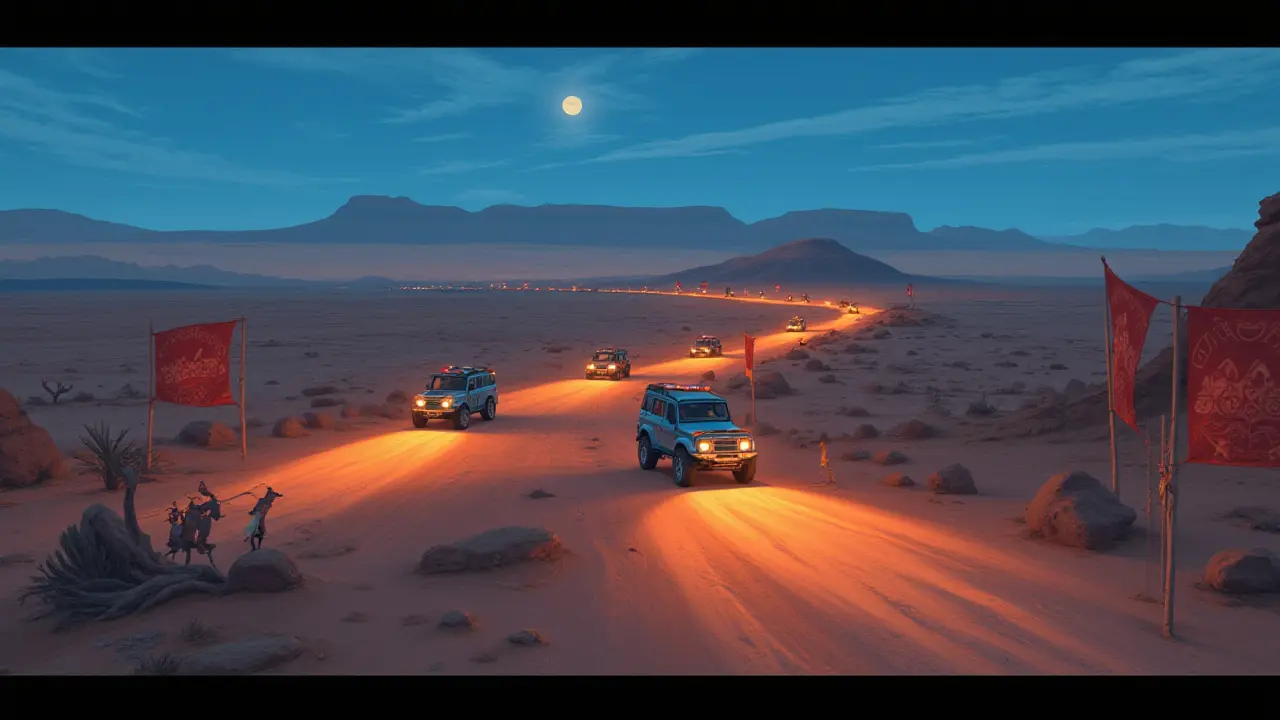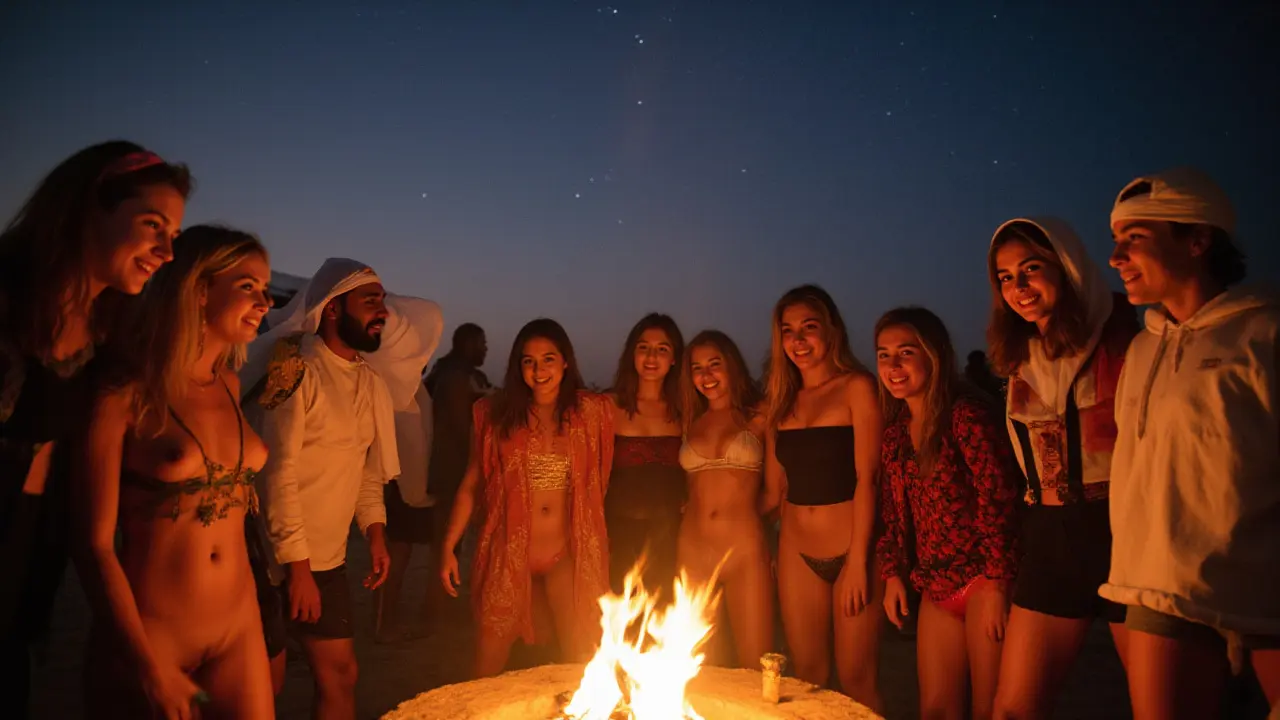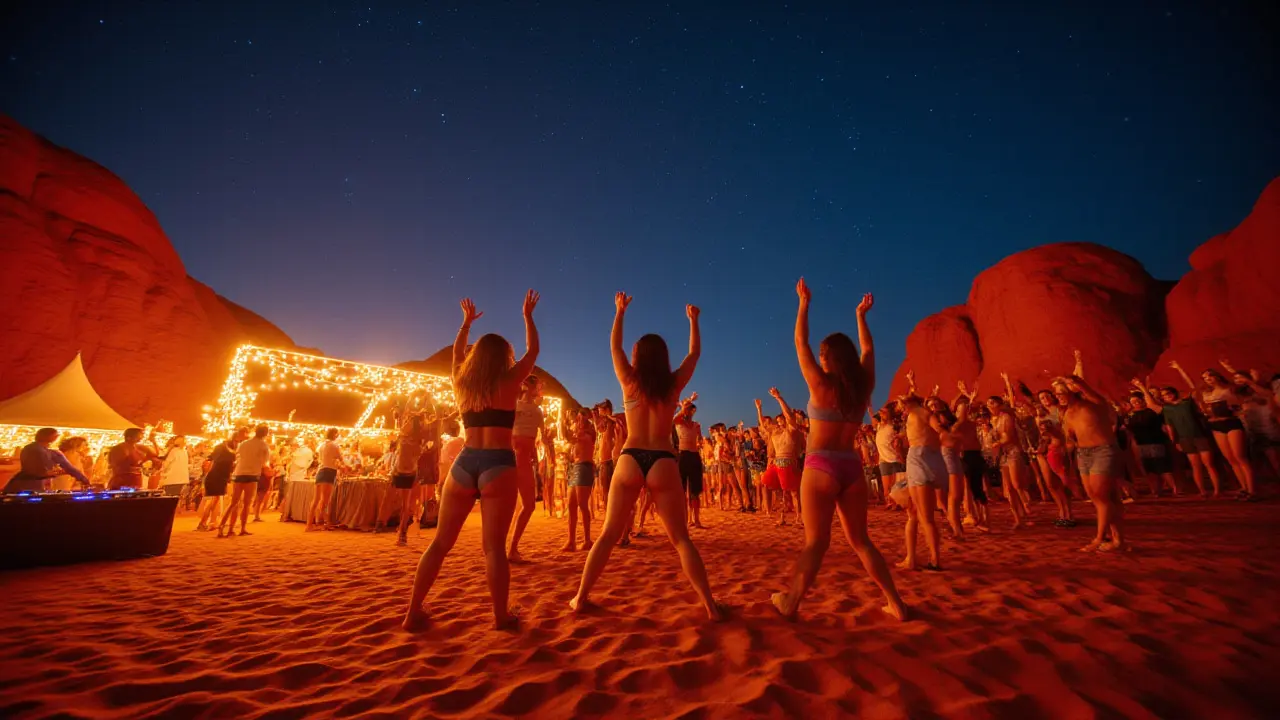Key Points You Need to Know About Desert Party Nights
- Australia's desert parties are exploding in popularity, especially near Alice Springs and in Western Australia.
- These events often feature music, camping, light installations, and open-air celebrations far away from city life.
- Pre-booking and preparation are essential since the venues are often in remote, harsh environments.
- Safety is a core concern—hydration, sun protection, and local wildlife awareness are non-negotiable.
- Desert party culture blends music, art, and diversity—it's more than just dancing under the stars.
Direct Answer: What Makes Desert Party Nights Unforgettable?
Desert party nights in Australia turn the humble outback into rave wonderlands. Picture this: sound systems thumping against an endless sky, fire shows and LED art glowing over the red dirt, and a crowd of locals, backpackers, and city escapees coming together. You're dancing barefoot with friends beneath the Milky Way, miles from the next power outlet. Everything here—from logistics to music—needs careful planning because a forgotten tent peg or empty water bottle can spell disaster. But when it all comes together, the sense of freedom, community, and pure joy is unmatched. These parties aren’t just gatherings—they’re built for connection, adventure, and stories you’ll be telling for years.
Comprehensive Guide to Australia’s Desert Party Nights
Take one look at the festival calendar for Australia’s outback, and you’ll see why party nights in the desert are all the rage. We’re talking about more than just music events—these are fully immersive festivals. They pop up under canvas canopies or moonlit dunes, drawing crowds from all over. Let’s set the scene. Imagine wild light rigs hauled hundreds of kilometers out past the nearest petrol station, DJs spinning for sunrise crowds, pop-up art installations that would feel at home in Berlin or London, and a community fueled by radical self-expression. Locations change from year to year, and the secrecy only adds to the thrill. Organizers often release coordinates just a week before the event to keep out the uninvited and protect fragile environments. In 2024, events like Subsonic, Rainbow Serpent’s outback sessions, and smaller, local gatherings pulled in thousands. While mainstream city festivals battle regulation, the desert crew thrives on autonomy—they build their own stages, power grids, even compost toilets. But the fun isn’t just in the wild creativity; it’s in the planning. You’ll find WhatsApp threads sharing advice from old hands—what boots to wear, how much water to haul, which UHF channel to tune in for emergencies. These parties aren’t for the faint-hearted. Distances are vast, and the desert can turn cold at night. But if you’re ready, the sense of discovery is real. Phones often lose signal, so the connections you make are face-to-face only. People bring their own music or workshops—everything from permaculture chats in the afternoon to sunrise yoga. The crowd is wildly varied, too—from grey nomads to daring uni students. And then, there’s the setting. When a full moon rises over Uluru or dunes light up in the gold of twilight, there’s no club roof in the world that can match it. That’s why thousands keep coming back. This isn’t just another warehouse rave—this is an all-senses adventure.
Definition and Context: What Are Desert Party Nights and Why Are They Trending?
A desert party night, in simple terms, is a music and celebration event set deep in Australia’s outback. Usually, these festivals are built around electronic music—think house, techno, psytrance, with the odd dose of Aussie indie or even didgeridoo jams thrown in. But there’s more to it. Unlike city raves, everything’s outdoors. The environment shapes the experience—campers set up under gum trees, and people wander art trails built into sandhills. There’s a mix of organizers: collectives with experience running street festivals, local Aboriginal groups sharing stories and crafts, and even environmental NGOs teaching outback survival. Why is this blowing up now? People are craving authenticity—no velvet-rope VIP lines or over-policed city venues. After COVID’s lockdowns, Aussies wanted space, and these desert festivals offered open skies, no masks, and a return to tribal feeling. Recent years also saw international DJs and influential Aussie musicians joining, drawn by the freedom and wild landscapes. Plus, social media loves a desert party snap—it’s not hard to rack up likes with a fire-twirling photo backdropped by ochre hills. In 2023, a survey by the Aussie music site Tone Deaf found that over 45% of young festival-goers were keen to try an outback party, compared to only 12% just five years earlier. It’s a trend powered by the search for stories, not just selfies.
Benefits of Attending an Outback Party Night
Jumping into an outback party night is about more than killer music. First off, there’s the sense of community. City parties can be cliquey, but here, everyone’s a local for the weekend. Strangers offer sunscreen, lend tent pegs, or share spare cold drinks without a second thought. There’s also mental freedom—when your phone dies, nobody’s doom-scrolling. People chat, play games, kick around frisbees, or learn fire poi. You’d be surprised how many lifelong friendships start at a jam circle beside rusty 4WDs. Another perk? The views—Australia’s desert at night is something you have to see to believe. You can spot shooting stars, satellites, even the odd passing kangaroo (yes, they do crash parties now and then). There’s usually space for day activities too, like stargazing workshops, yoga, and tours with local trackers who explain bush survival. And if you’re creatively inclined, there’s a spot for you—most festivals invite you to bring your own art, whether that’s a paint mural, new music set, or just wild costumes. Some even have artist grants for big installations. Don’t forget self-reliance. The outback teaches you to look after yourself. Remember, no Uber Eats out here. But that’s part of the fun—it’s about working together, sharing gear and skills, and learning real survival tips. If you snag an early ticket, you also dodge peak prices. These festivals are usually cheaper than city events, since there are fewer overheads, but bringing your own kit levels the field even more.
Types of Desert Parties Rocking Australia’s Outback
Wondering what flavor of party to chase? There’s more than one kind in Australia’s deserts. Some of the big annual tribes include:
- Music-Driven Raves: These are the iconic desert dance events centered on big sound systems and lineups running dusk to dawn—think the Splendour in the Grass crew gone walkabout, but with more grit.
- Art and Light Festivals: Here, visual artists turn dunes and riverbeds into pop-up galleries. It’s a bit like Burning Man but with more kangaroos. Expect LED sculptures, immersive sound walks, and workshops.
- Community Gatherings: These focus less on music, more on cultural sharing. Typical at spots like near Coober Pedy or the Pilbara, you’ll find local Indigenous guides running sessions on bushcraft, stargazing, or culture.
- Secret ‘Doofs’: The Aussie ‘bush doof’ is legendary—invite-only parties organized through private Facebook groups or text chains. These are known for pure freedom (and epic tales shared next morning over instant coffee).
- Festival Hybrids: Rainbow Serpent (when it goes outback) and Subsonic mix traditional festival acts (comedy, yoga, workshops) with wild music marathons.
If you’re headed out for your first time, stick to public or ticketed events—they’re better organized, with proper permits and medics on hand. But if you land an invite to a secret doof, treat it like winning golden ticket—just respect the code: pack it in, pack it out, leave no trace.

How to Find Outback Party Services and Plan Your Trip
You don’t need secret connections—most big desert events advertise online. The festival calendar at inthemix.com.au and OzDoofers Facebook groups are legit places to start. Eventbrite and Humanitix list mainstream and obscure desert events months in advance. For families, Outback Festival in Winton is a staple; for ravers, Desert Dreaming near Alice Springs is a must. Planning is everything. Book tickets early—many sell out quickly. Organizers usually send a packing list, but basics include extra water (plan for at least 5L a day), snacks since food trucks close after 2am, a sturdy tent, boots (thongs won’t last past midnight), and a hat. Most festivals offer group shuttle buses from nearby towns like Alice Springs, but others need a 4WD. Download offline maps—service drops out an hour out of town. Once you’ve got gear sorted, lock in your crew—solo partygoers are welcome, but a buddy system saves headaches. Tip: Dress for extremes. Temps can hit 40°C by day, but drop below 10°C at night. Bring layers and a torch; outback fire ants don’t care how cool you look in the dark. Some festivals sell ‘eco’ upgrades, so you can land a compost loo or solar shower spot. For something different, check out desert glamping packages—canvas bell tents with real beds, priced for those who like comfort. Getting home? Designate a sober driver and leave extra water for the road. There’s no servo open at 4am on the Tanami Track.
What to Expect at a Typical Desert Party Night
If it’s your first time, the drive out is half the adventure. Roads turn to red dust, the landscape goes from scrubby plain to rolling dunes, and suddenly a flicker of colored light means you’ve found the nook. Arrivals usually set up camp—most desert parties run for two or three nights. There’s a bit of a festival dance as folks stake out the best shady corners. By sundown, everyone’s sharing stories, queuing for food trucks (kangaroo burger, anyone?), and meeting neighbors. As darkness falls, things shift. Sound systems turn on, and you’ll feel bass pulsing through the ground. Fire shows, live bands, and impromptu performances pop up between themed zones—maybe you wander from a yoga dome to a psychedelic light tunnel, then hit the dance area. Don’t expect to stick to a rigid set list—most itineraries are loose, and best moments happen off-schedule. When you need a breather, you can lie back in a stargazing hammock or hit workshops—popular for everything from didgeridoo lessons to tie-dye sessions. Sunrises are magic: hundreds watching pinks and oranges spill across the horizon, coffees in hand, swapping stories. Hygiene’s rustic but effective—most events run compost toilets and communal showers. And for security, check-in staff scan all wristbands and hand out free sunscreen sachets. Medics are on-site (though for minor scrapes, most rely on a well-stocked communal first aid kit). As for substances, much is self-policed—Aussies know how to party and look out for each other, but every festival has ‘chill zones’ for those needing a break. At the end, clean-up is communal. Everyone grabs bags to pick up trash, building that feeling of shared stewardship. First-timers usually leave sunburned but satisfied, with memories you can’t get at a city club.
Pricing, Booking, and Useful Cost Data
Desert festival prices vary, but compared to eastern-seaboard city events, they’re a steal. Most multi-day tickets range from $150-$250, which usually includes camping and access to all workshops and art shows. Some headline fests with international DJs (like Earth Frequency or Subsonic when hosted up country) run closer to $300, but still lower than top-tier city festivals. Glamping upgrades (bell tents, breakfast packages, power outlets) add anywhere from $120 to $500 depending on options. Food stalls charge $10-20 per meal; drinks are either BYO or about $8 for a cold beer. Shuttle buses to and from nearest towns (Alice Springs, Kalgoorlie, Winton) are $40-70 return. Many events offer group or early-bird discounts. To save money, bundle your gear with mates and carpool—the biggest hassle is hauling supplies. Booking is all online now, but most events use low-fee Aussie ticket platforms to avoid scams.
| Feature | Desert Party | City Festival |
|---|---|---|
| Multi-day ticket | $220 | $429 |
| Camping included | Yes | No (add $150) |
| Shuttle bus return | $60 | $18 (public transport) |
| Catering | $15/meal avg | $14/meal avg |
| Onsite art workshops | Included | Extra $60+ |
| BYO alcohol allowed | Yes | No |
Outback Party Safety Tips Every Attendee Should Know
Safety is not optional in the outback. Temperatures fluctuate wildly, and dehydration sneaks up fast. Always drink more water than you think (electrolyte sachets are a winner). Wide-brim hats and UPF shirts can spare you days of sunburn. Keep an eye out for local wildlife—dingoes and snakes are shy, but don’t leave snacks out at night. Never wander from the marked areas unless you’re with a buddy. Mobile reception dies after the first sand dune, so always log the event’s UHF radio frequency—or check in at the info tent on arrival for emergency plans. Ear plugs are more valuable than gold if you need sleep. Pack a pocket torch—those pop-up art trails become pitch-black after midnight. Personal security? Outback festivals are mostly safe, but lock valuables in your car. Don’t forget your own first aid kit (think: band-aids, antihistamines, tweezers). If you’re driving home after, get a proper sleep first—outback roads demand focus. Fire bans are strict; don’t light your own, and report any suspicious smoke to the crew. For those new to long drives, download the NSW Rural Fire Service or BOM weather app for up-to-date warnings. And most importantly—leave no trace. Respect the land, pack out your rubbish, and remember: the desert was here long before we all showed up with our sound systems.
Comparison Table: Desert Parties vs. City Festivals in Australia
| Feature | Desert Party | City Festival |
|---|---|---|
| Setting | Natural, remote, under stars | Urban, in stadiums or parks |
| Music | Eclectic, outdoors, sunrise sets | Set schedules, headliners indoors |
| Camping | Always included | Rarely included |
| Community vibe | Inclusive, self-reliant | More anonymous |
| Wildlife | Possible | Unlikely |
| Onsite art & workshops | Included | Usually paid extras |
| Pack it in/pack it out | Essential | Not enforced |
| Weather challenges | Hot day/cold night | Usually mild |
| Noise restrictions | Little to none | Strict urban curfews |
| Price | Cheaper | Higher |
FAQ: Your Questions About Desert Party Nights Answered
- What’s the best time of year for outback parties? Winter months (May–August) are safest—cooler nights but no roasting daytime heat.
- How do I get tickets for secret doofs? Word of mouth is key—join local online groups, respect entry rules, and don’t spam for invites.
- Are these parties family-friendly? Some festivals run family areas and quiet camping but ask before booking—others are pure grown-up playgrounds.
- Can I bring my own drinks? Many festivals are BYO, but always double-check—alcohol bans apply at some protected sites.
- What should I never forget to pack? Water, sun cream, head torch, hat, and a sense of humor. If you’re prone to hayfever, bring allergy meds.
- Is there phone reception? Rarely—assume you’ll be offline once you leave the last highway town.
- Do I need a 4WD? Check the event site—some locations are sealed road access, others strictly 4WD only, especially after rain.

Ready for Your Outback Party Adventure?
So, are you up for dancing under the stars, swapping stories around the fire, and discovering the wild side of Australia’s desert parties? Grab your kit, rally your mates, and add a desert festival to your bucket list this year. You’ll come back with more than just red dust in your boots—you’ll collect memories that city lights can’t even touch.
